Good Business Update
2023’s progress and milestones on the road to better
Every year, we’re making choices that help minimize our impact on the planet. Check out the 2023 update to see how far we’ve come.
We accept:

Bellroy started as a brand based on leather, and we have spent the past 10 years extolling its virtues as a product material, while also working damn hard to improve the leather industry and its supply chain. So it might seem surprising that we’re here to talk about a promising plant-based leather alternative that we’ve been developing in collaboration with Illinois’ Natural Fiber Welding. Hear us out.
We still think there are many great things about leather. But we’re continually exploring what ‘better’ looks like, as we progress towards a regenerative future. Until recently, the leather alternatives out there posed too many other sacrifices to the environment for us to consider them. We looked into them – hundreds of them.
Then came Natural Fiber Welding, and their “high-performance plant-based material with 100% natural inputs”, called MIRUMⓇ.
Because our goals are big picture, when we invest in the progress of a new material (or supplier), we want to make sure it will ultimately benefit the planet on a large scale. We partnered with Natural Fiber Welding because we believe they have the potential to achieve genuine circularity, as well as commercial viability. And, we knew we could use our deep leather expertise to help further their production of a viable and legitimate alternative.
Now, we want everyone to know about it – our competitors included.
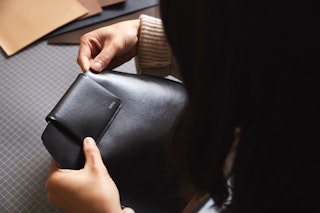
So we hosted a call with the founder of Natural Fiber Welding, Dr Luke Haverhals, led by our own co-founder, Andy Fallshaw. When two business leaders – one a product designer and the other a chemist, both deeply passionate about improving the planet – get together, you know it’s going to get interesting. And a little technical. But there’s a lot of baking analogy and cake chat to balance things out. Read on for the highlights of that conversation, or watch the full (hour-long) conversation.
"We were just chemists trying to figure out what the laws of the universe could allow us humans to do with all natural materials." – Luke

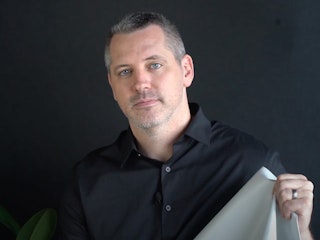
Andy: Bellroy and NFW started working together two years ago. Sustainability, working on a better Earth ecology and chemistry are all major motivators for both of us. How do you see the world and the challenges that you’ve set up Natural Fiber Welding to tackle?
Luke: The most succinct way to say it, is, everything – us as individuals, our clothes, our bags, the things we have around us – has ‘where it comes from’, and ‘where it’s going to’ stories. NFW is set up to think about how we solve problems holistically. So there aren’t never-ending cascades of interventions.
You [Bellroy] are making these products that are meant to last as long as possible. And that’s one of the key things. There’s so many people who make a thing that doesn’t last very long, is not well made or is made for a trend, and all of a sudden you have to replace it. But when you make high quality things, that do what they’re supposed to do, and last a long time, then you don’t have to part ways with it.
But everything has a lifetime. We think holistically about where materials come from, and in the form of products, where these materials are going to go, and how we can partner with people like you and the Bellroy team on making products that have an integrated, holistic answer.

A: I love it. So, the major two platforms you have – MIRUM and CLARUS®. Can you talk about what each of these are and the way they’re trying to address that opportunity that you’ve outlined?
L: CLARUS is the platform for how we think about textiles. MIRUM is the ingredient brand for all the things that you have to do well when you’re working with leather-like materials. So, there’s already leather in this world. There’s already synthetic – some would call them ‘vegan’ (but we’ll get to that later) – leathers. MIRUM is a new platform for when you need a leather-like material. There’s a broad ecosystem of materials that are possible. Just two of them we have names for so far, but there’s a lot more of the ecosystem to come.
Back when I was working at the US Naval Academy, we were working on making new things from bio material and biomass. Back in those days we didn’t have any one application in mind. We were just chemists trying to figure out what the laws of the universe could allow us humans to do with all natural materials. And so, one of the things we discovered is that you can take natural fibers and basically make them weld or fuse together. Not just cotton, hemp. But wool and silk and all the natural fibers out there. If you can get fibers to fuse, you can make textiles that are more durable, that wick moisture more effectively, and are more breathable. Today, many of the performance fabrics that we use in the world are made from plastics – because plastic can be moulded and extruded into different kinds of shapes. But, we have invented a way to open up those possibilities to the natural world.
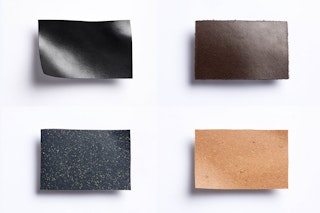
'If we can learn to tap into these cycles, then this isn’t just a ‘hippie dream’ about peace, love and mung beans… it can actually make commercial sense.' – Andy
A: The way you use ‘natural’ is a little different. With other brands, we hear ‘natural’, but in the processing of those things there are often unnatural ingredients, synthetic waste – petrochemical, hydrochemical, activations, catalysts and things like that. Can you talk a little bit about your semi-puritanical stance on the sorts of ingredients you want to work with?
[And so begins the baking analogy, that made many of us hungry for soufflé.]
L: Yeah. That’s right. Think about your kitchen. Your kitchen has flour, eggs, sugar, water, milk… and maybe a cabinet with a bunch of special spices and things like that. But with that standard pantry, you can make soufflé and pancakes and birthday cake and graham crackers and all these different types of things. Depending on what the recipe is and how you mix and treat the materials. We take it for granted that when we start making bread from our pantry, we don’t put those ingredients in some chemical digester and digest them down to some sort of soup, and then put it in another reactor that builds it back up to some sort of precursor to polymer and then mix it with plasticizers and all these things. We just take the natural ingredients, as they are. We might grind the flour finer or something, but we have this intuition around how we bake and how we cook, and that’s what NFW is.
When you think about where plastics come from, they come from this amazingly complex (and expensive!) system where we dig up these materials from the ground and we put those materials through a whole bunch of different kinds of technologies that are designed to build uniform chemical molecules that then get combined and put together and catalysed and heated… to make regular things (polymers, let’s say). And then those polymers get compounded with plasticizers and other things. Think about all the oil rigs, pump jacks, refineries, factories that take the petrochemicals out of the refineries and then the polymers get laid up and then... OK. [He takes a breath.]
All of that stuff, to make a ‘leather-like’ synthetic material!
What if you could just take cork, other ground up lignocellulose [plant dry matter for those playing at home], waste cotton, industrial hemp, vegetable oils and natural rubber… and combine those materials directly as they are – in the same way as when you bake bread you use the flour as it was ground up from the field – and, just like there are some techniques you use to make soufflé and different techniques to make a multi-layer birthday cake… well, here you go [holding up a sample of MIRUM, which looks like a strip of leather]. There were no pump jacks and oil rigs and fleets of ships. This, you can make from the field.
When you’re looking at a tree, you’re not only looking at an amazing, beautiful thing, but from a chemistry perspective and a manufacturing perspective, the way in which those materials are arranged is wonderfully complex. And if you’re going to break that down, not only is that going to cost you money, you’re going to destroy all of that order and structure that the natural thing had. So, we take it for granted that we can get these things at low cost, and from sunlight, and soil. If you can cook with those things directly, it ends up being not only the lower cost way to go, but the higher performance way to go as well.
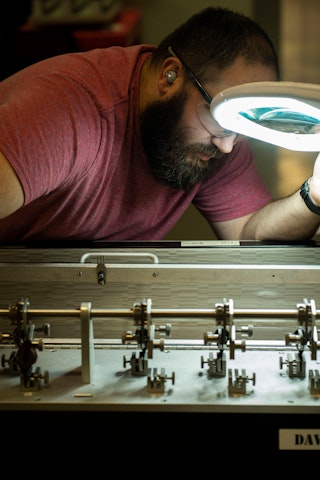
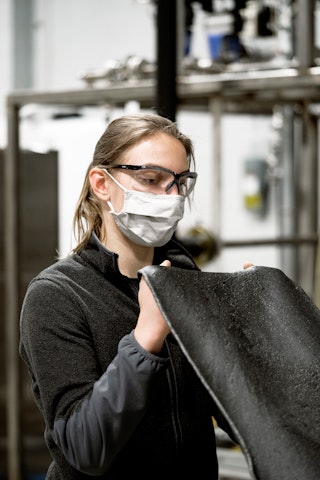
A: Cradle-to-cradle was a hugely influential text for me, and in that they outline this idea of the two major material streams that we can build products from. One is biological nutrients, which can go back into the Earth, be decomposed, broken down in natural cycles and then will rebuild. And the other is the technical nutrient stream, which is the petrochemical side of things (a lot of synthetics), where the goal is for it to be recycled. Choose your stream, and [that determines whether] at the end of life you decompose it or recycle it.
So then, in the family of leather-like materials you’re holding... they’re a bit different! What we have is a material that, because it’s all natural, you could send off to decompose and be broken into nutrients, or, pull it apart and recycle it, use it again. For me, that felt like a fundamental paradigm shift.
L: Yeah. Part of the reason why plastics are typically not recycled, is because most products are complex mixtures. There’s some incremental improvements when you have clear plastic bottles, then you can extrude that into a textile fiber, and call it recycling. But it’s a one-way function into textiles and textiles are not recycled. It’s a second use of that technical nutrient, but it’s not anything one would consider to be a loop.
Let’s go back to the tree. The tree is made up of many different kinds of materials. And yet nature knows how to recycle it. Trees fall in forests, the forest doesn’t have to figure out how to compost the tree. The tree falls apart on its own time frame, and that’s totally fine.
So how do we get more possibility out of the natural nutrient cycle, knowing that there’s this one thing within the technical nutrient cycle that humans have been able to do amazingly well – [create] an ecosystem of things that are moulded and shaped and all of the things that make great products. How do we take that idea, and bring it over here?
A: The way I interpret this, is that there’s an acknowledgement of the interconnectedness of life, and of the different stakeholders on our planet.
L: That’s a great way to put it.
'What we seem to have is a material that, because it’s all natural, you could send off to decompose and be broken into nutrients, or, pull it apart and use it again. For me, that felt like a fundamental paradigm shift.' – Andy
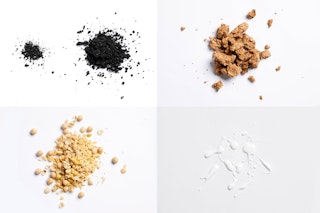
A: At Bellroy, we like to think of people, animals and the planet, and how we do things that build a nurturing loop for those three major stakeholders. There are parts to technology and the innovation that has happened over the past 200 years that have been incredible for bringing humans out of extreme poverty, improving child mortality, improving life metrics... But often it’s been at the expense of animals or the planet. Large scale commercial agriculture has all sorts of issues, when we start to monocrop and take massive fields and try to eliminate everything that doesn’t feel ‘controllable’ and once you do that, you’ve got a pest that could take over, so you need a pesticide and you’re depleting the same nutrients out of the soils with every single cycle, so you need synthetic fertilizers to try and replace those... Every time we try and eliminate all variables, we get into these intervention stacks with all these challenges.
To me, what you’re saying is, look for the natural ecosystems that have a balance – they already understand cycles, and work with those in ways where you’re not trying to isolate everything, pretending you can eliminate all the other complexity.
L: Yeah, well said. Think about industrial agriculture for a moment. Going back 120 years, we could acknowledge that the folks first getting oil refineries were making a product that was displacing the whale blubber industry. We were hunting whales to extinction at a certain point in time just to light our homes. You could argue that the petrochemical industry has its roots in the ‘green chemistry’ of its day – better than hunting whales to extinction. But, the petrochemical refinery production system seeks uniformity. Because you want your stainless steel reactors and things to operate under certain standard conditions. And so, chemists have been so focused on fitting everything into that production model.
Some of the philosophy and approach of mass production and uniformity that works so well also works against us when we try to apply it to everything. In the meantime, nature is abundant, and it’s diverse. So we don’t seek uniformity in the same way. Of course, if Bellroy is going to make one of your fine wallets, then you need this material to perform to certain threshold quality attributes – that’s non-trivial. But when you do take care of that, and you can take care of it with different kinds of sawdust, or different kinds of natural fibers, different kinds of oils... you can get to the ultimate system, which is a regenerative system.
Nature knows better how to heal planet Earth than humans do. And when we make sure we fit in and achieve balance within that ecosystem, everything around us gets better.
A: If we can learn to tap into these cycles, then this isn’t just a ‘hippie dream’ about peace, love and mung beans… it can actually make commercial sense.
And if this is actually going to reach scale, it’s really important that we understand how to make it commercially viable. Can you talk a little bit about why you believe this can actually make a real impact?
L: When NFW started, there was no question around whether it will come from materials that are low cost and abundant. The original circular economy starts with a green plant. There’s so much in the natural economy around us that we just take for granted. And there’s way more than we need. Way more. So, I didn’t worry about the price of these biomaterials. I wasn’t worried about diversity. I wasn’t worried that we were ever going to be reliant on one kind of crop or another.
The question was… from that diversity, can you get an emergent set of properties for a leather-like material that is going to have the strength, the elongation. We take for granted what kind of amazing engineering is in a tree. When you see a tree and its huge, cantilevered beams out there swinging in the wind... you can’t make synthetic systems that do that, let alone ones that can replicate themselves. So, nature has this performance.
When we get deep in the weeds with companies like Bellroy, [we’re considering the] price to performance ratio on the product, and how it’s all going to come together. If you can balance those equations, that gets you working towards regenerative.
'Of course, you need this material to perform to certain threshold quality attributes. But when you do take care of that, and you can take care of it with different kinds of sawdust, or different kinds of natural fibers, different kinds of oils... you can get to the ultimate system, which is a regenerative system.' – Luke

A: This isn’t just a pipe dream. We have to really understand these economic incentives and drivers and understand what sorts of changes have a real chance of reaching impact and scale. If we’re trying to replicate [the petrochemical industry’s] hundreds of trillions of dollars in a short term to get a new material up and running, it’s just not going to happen. So, we need to find a new way to bring it into an economy and ‘tap’ it in a way where we know we are drawing on things that are abundant and not things that are scarce.
L: Sometimes I’ll tell people that I’m an accidental entrepreneur. I was very ignorant. To start a company like this, you have to have a healthy dose of optimism and a good amount of ignorance to go with it. That being said, with any good idea, if you can bring the right people around it, if you can collaborate and share and let other people with other skill sets and points of view bring in the value that they can bring in, then good ideas can happen and they can flourish. We live in an amazing time in history, where someone on a completely different continent to me, literally on the other side of the world, can collaborate and share ideas. You can bring your deep expertise, and I can focus on making a couple of materials that might help you do what you do with an improved price to performance ratio.
Now we can start thinking about Bellroy’s supply chain – and NFW isn’t going to be just in Peoria, Illinois, very quickly we’ll be in different parts of North America and on other continents! I’m really grateful to a whole bunch of people. It certainly wasn’t just Doctor Luke all by himself, sitting in his basement.
A: We say in Bellroy, that when ‘smart people, with good intentions, who can get shit done’ come together, it’s like, yeah, stuff will happen.
L: A much pithier way to put than I did! I totally agree.
A: When we started the journey, there was the ‘raw’ state of MIRUM, this putty-like material…
L: Dough! Like dough!
A: Yes, back to the cooking analogy… You can push that through rollers and compression mould it, and shape and form it into different thicknesses. You could also create harder and softer zones. You can hybridize it with the CLARUS and start to have coatings. The potential...
[Luke starts punching a board of fused samples to prove its density.]
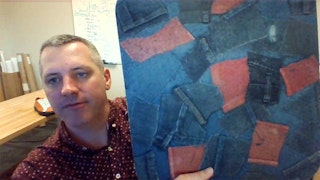
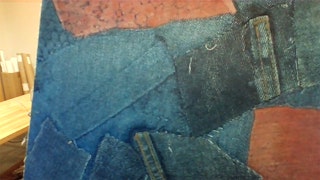
This is actually blue jeans. Nothing but blue jeans. There’s no glue. And it’s strong. We design this so that it feels great, but you can rip this part off, make this bit an ingredient for something else... These are doughs we can make again! You can grind things up in particular ways and get re-moulded, re-shapeable dough. Sometimes, it’s even better just to grind it up and give it back to nature. But, if you have the supply chain and the material is already there, and it’s already in the factory, and you have cutting scraps and just put it back into a system that makes it dough again – that’s less dough you have to make for the next batch. There’s all kinds of waste that goes into making things even for the first time. And when you can solve those deep, embedded problems, with something where unit economics drive that solution, then for better or for worse, businesses make money. And the goal is to make the money in a responsible way where you have the right incentives to drive regenerative practices. Not just sustainable, not just circular. We really need regenerative systems – systems that self heal. These materials can be self-healed, once you’ve ground them up and torn them apart, you can put them right back together again and they heal back up.
'Bellroy is a brand that started with leather and we’ve done everything we can to try and make leather better, we’ve worked on animal welfare, we’ve worked on effluent sustainability… but we’re not wedded to leather. The reason we haven’t used synthetic leathers previously is that they come with this whole other bundle of problems.' – Andy
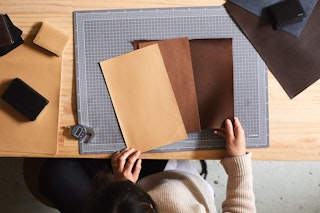
A: It’s so lovely. And sometimes, some of us who think through the sustainability space have trouble with the word ‘sustainability’.
L: Yeah, it means everything and nothing at the same time!
A: And instead, what about ‘regenerative’ where every cycle, every time around, it can still be updated with modern context, it can still be given a new form that resonates and has relevance in the world as it is right now, and we’re not trying to sustain something that has other issues.
L: There are a lot of people in the world who say the word ‘sustainability’, but it’s not tied to any real measurement. People either hide information, or the information they have is so at the surface and not tied to any real measurement of a significant problem that it doesn’t mean anything.
We’re fortunate in that nature already solved a bunch of problems we didn’t have to solve, and with the right approach to the technology you can solve lots of problems… And that’s the thing, we’ve been working together for a while now. On day one, we didn’t have something perfect for you. And we’ve learned a lot, because you taught us where we were falling on our faces! But in time, you build trust, you build common context and knowledge, you measure the right things together, you solve the right problems, that’s the blocking and the tackling that wins the day. In the end, NFW should sink or swim on its own merit and the kinds of problems that it solves. Let’s just make sure we’re measuring it properly so that over time the resources go to the things that actually solve the right problems.
A: I love that so much. And, as humans we all have blind spots. We all have lenses we see the world through and just as we want diversity in our ecosystems, we want diversity of thought. And that’s to help unearth and recognize some of those blind spots. There’s not one good and one bad. The world is not polarized into black and white. So when we measure, we never want to measure only one thing. I don’t know of any human that has one goal in life… why would a business only have one goal in its life? We need measurement and we need to continually be open to things that we haven’t measured yet.
One of the things I always cherish about the time we have in these conversations, is that essentially it’s a story of optimism. It’s like, open up to the fact that when we adopt a new technology, there must be benefits, but there will be negatives too.
L: Right.
A: Every new technology comes with downsides. But it’s about stopping wilful blindness. Getting the heads out of the sand. We’re not going to solve this by removing technology. Technologies have serviced us in many great ways. But there are choices – there are better technologies that come with fewer negative externalities, fewer downsides. So, can we choose the technologies that not only have fewer downsides immediately, but actually lead us towards greener pastures, better practices, drawing on abundant systems rather than scarce systems.
Bellroy is a brand that started with leather and we’ve done everything we can to try and make leather better, we’ve worked on animal welfare, we’ve worked on effluent sustainability… but we’re not wedded to leather. The reason we haven’t used synthetic leathers previously is that they come with this whole other bundle of problems. They’re petrochemical derived, they have all sorts of toxins. There’s a lot of other synthetic leathers that feel like they should be a good thing – they use a little bit of cactus or something – but when you actually look into it, the backbone of it is still petrochemical. So we haven’t wanted to begin with a new platform that isn’t leading somewhere great. The thing I take out of this conversation, is that it is an optimistic story, if we choose the right technologies and we work really hard. How can we get a plant-based leather to perform better than grown leather? How can we get the properties more diverse, more custom and specific and fit for purpose? How can we actually build better performance that is still at a great price?
For me it is a story of optimism and if we’re demanding and open to the real consequences, if we’re measuring the right things, there are genuinely better technologies here and that’s what we need to get on board with.
L: Do I even need to say anything else? I mean, I’ll just say, thank you! And along with optimism, it is gratitude. I totally agree, Andy. There are so many things to be grateful for and optimistic about. Let’s roll up our sleeves. Because everything has an impact, we’ll never be done. But hopefully we’ll leave things in a better state than we found it.
I had a really dear friend in the Naval Academy named Matt who used to sing this song in the lab called ‘Cleaner than we found it’. There’s deep, deep wisdom in that simple phrase.

Read more about Mirum, and Natural Fiber Welding >
Read more about our materials >
Sign up for updates on our Mirum product development >
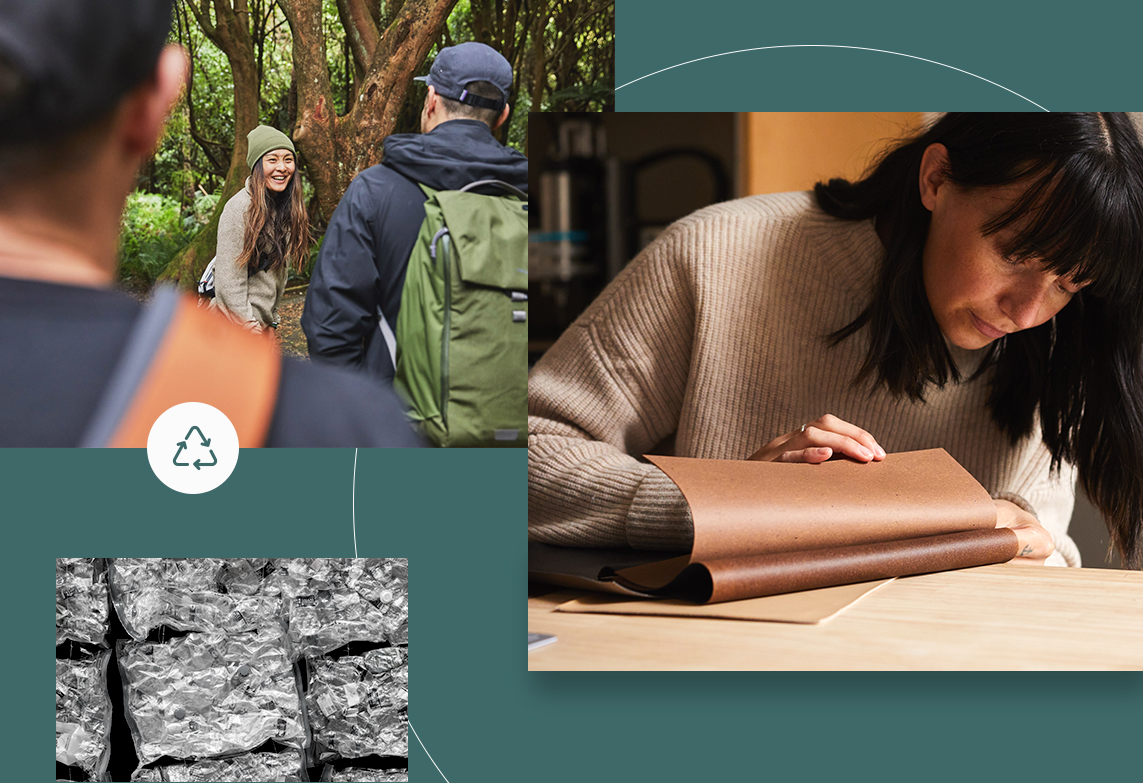
Every year, we’re making choices that help minimize our impact on the planet. Check out the 2023 update to see how far we’ve come.
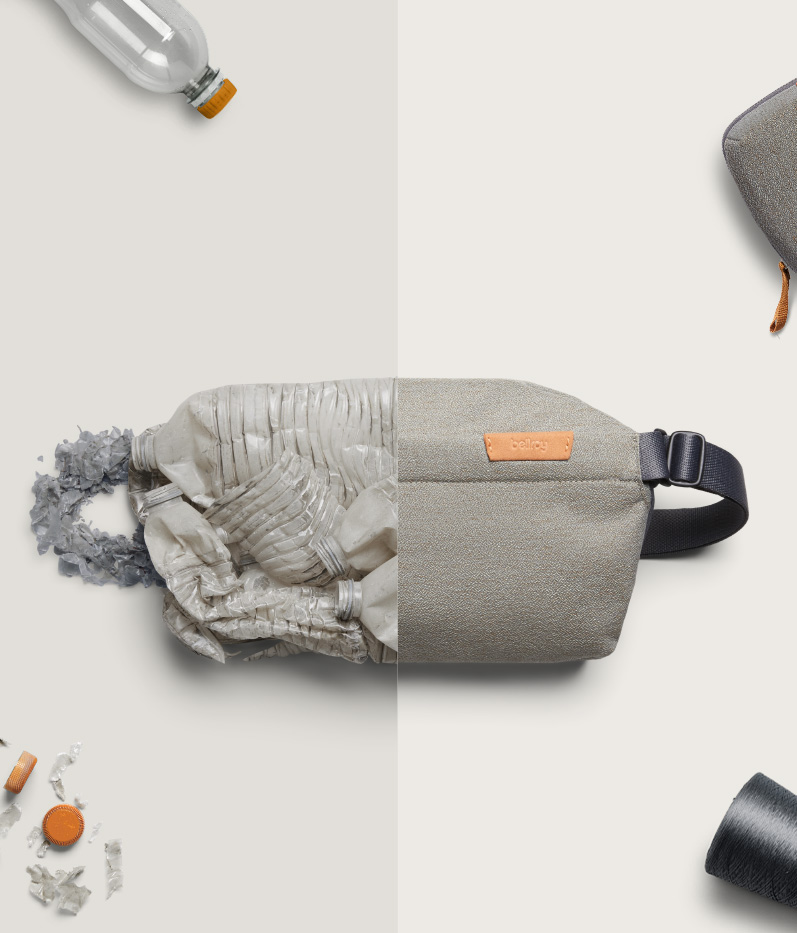
Is leather evil? Is plastic bad? We recently hosted a panel of material innovators, to discuss how the path to greater sustainability is paved with compromise and creativity.
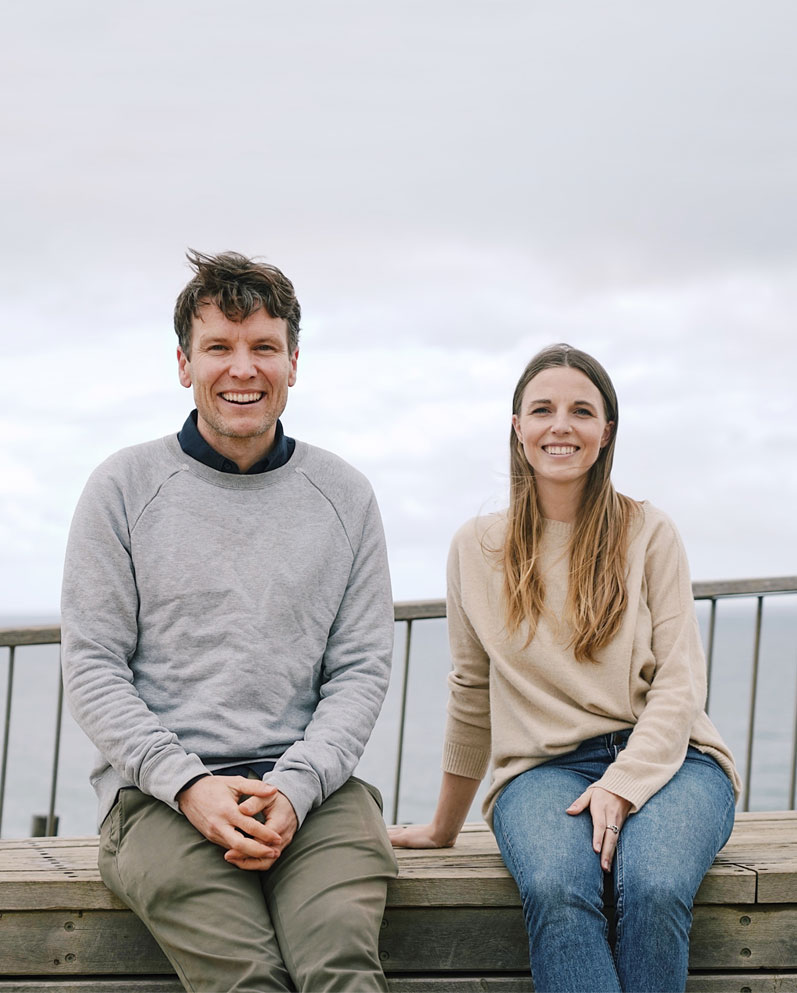
Straight-talking sustainable fashion expert, Teslin Doud, puts Bellroy co-founder, Andy Fallshaw, on the spot.